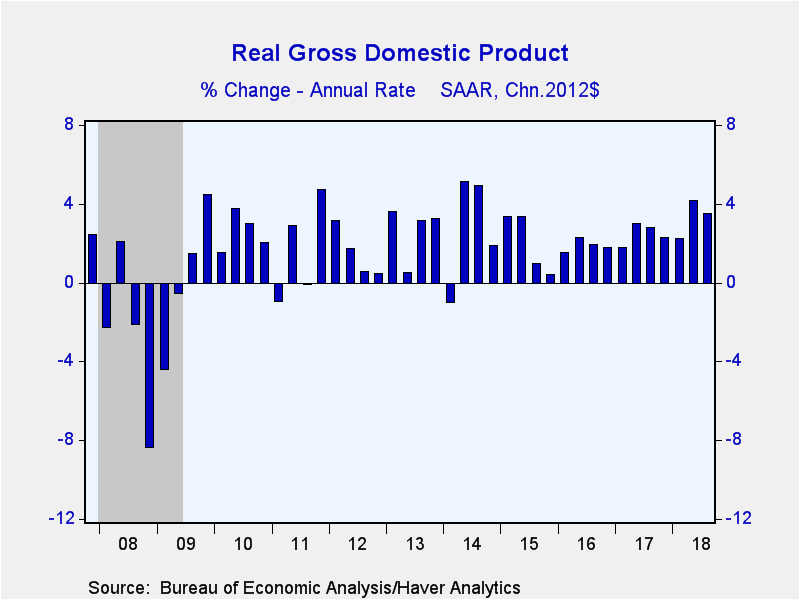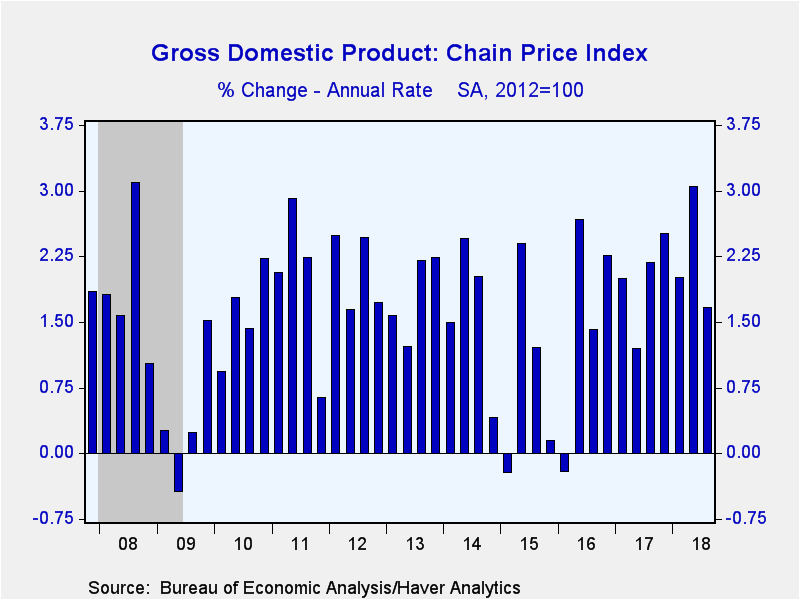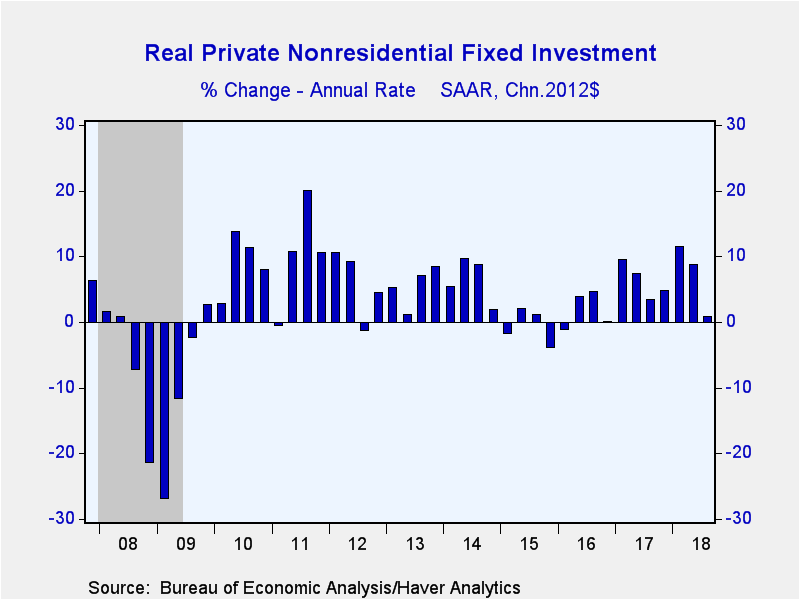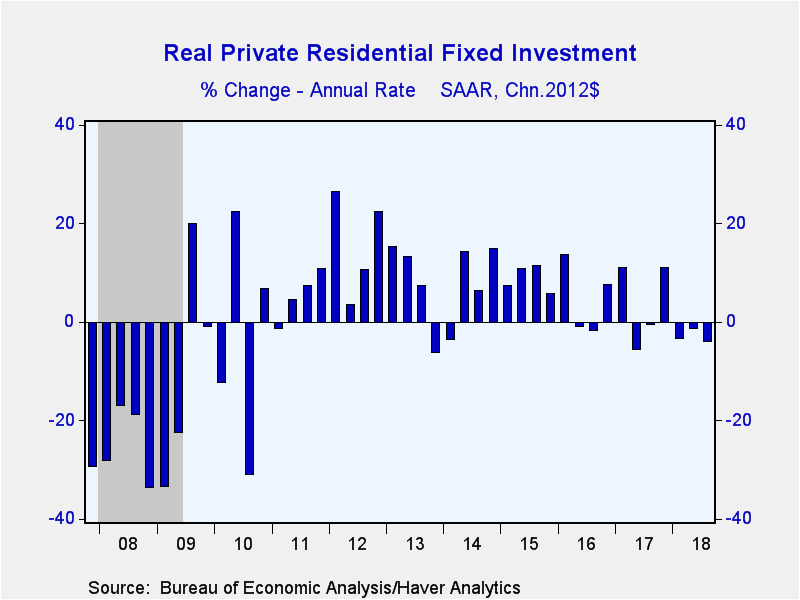 Global| Oct 26 2018
Global| Oct 26 2018U.S. GDP Growth and Price Gains Ease
by:Tom Moeller
|in:Economy in Brief
Summary
Real gross domestic product increased 3.5% (AR, 3.0% y/y) during Q3'18 following a 4.2% rise in the second quarter. A 3.3% advance had been expected in the Action Economics Forecast Survey. Supporting economic growth last quarter was [...]
Real gross domestic product increased 3.5% (AR, 3.0% y/y) during Q3'18 following a 4.2% rise in the second quarter. A 3.3% advance had been expected in the Action Economics Forecast Survey.
Supporting economic growth last quarter was accumulation of inventories which added 2.1 percentage points. That followed a 1.2 percentage point subtraction in Q2. Countering the addition was a 1.8 percentage point subtraction from growth due to deterioration in the foreign trade deficit which followed a 1.2 percentage point Q2 addition. Exports declined 3.5% (+3.9 y/y) after a 9.3% rise while imports strengthened 9.1% (5.7% y/y) following a 0.6% dip.
Growth in domestic final sales eased to 3.1% (3.3% y/y) after a 4.0% Q2 gain. Growth in personal consumption expenditures, however, was fairly steady at 4.0% (3.0% y/y). Spending on goods also was stable and strong at 5.8% (4.3% y/y). Spending on durable goods grew a lessened 6.9% (6.4% y/y) as recreational goods & vehicle purchases surged 12.4% (10.2% y/y). Spending on home furnishings & appliances advanced an accelerated 7.4% (6.7% y/y) while growth in motor vehicle & parts buying slowed to 3.8% (3.0% y/y). Spending growth on nondurable goods accelerated to 5.2% (3.3% y/y), the quickest rate of growth in over five years. It was bolstered by an 11.7% surge (5.4% y/y) in clothing purchases, as food & beverage spending advanced 4.0% (3.7% y/y). Spending on gasoline & other energy products fell 2.8% (-0.8% y/y). Services purchases advanced 3.2% (2.5% y/y), the quickest rate of growth since Q4'14. It was bolstered by a 6.9% rise (4.2% y/y) in spending at restaurants and a 4.6% increase (2.6% y/y) in spending on health care. Spending on housing & utilities grew a lessened 1.8% (1.7% y/y).
Holding back the rise in final sales was a modest 0.8% gain (6.4% y/y) in capital spending which followed two years of strong growth. The rise was restrained by a 7.9% drop (+5.1% y/y) in structures outlays, the first decline in a year. Equipment outlays rose slightly (5.8% y/y), though industrial equipment purchases surged 10.2% (4.7% y/y) after a 3.1% decline. Investment in information processing equipment advanced a weakened 3.5% (8.7% y/y) while transportation equipment outlays declined 9.1% (+3.8% y/y). Outlays on intellectual property products strengthened 7.9% (8.2% y/y), fueled by a 50.0% surge in software investment.
Weakening by 4.0% (+0.4% y/y) was residential investment, down for the third straight quarter.
Government spending grew a strengthened 3.3% (2.4% y/y), the quickest advance since Q1'16. Federal government outlays increased a steady 3.3% as defense outlays surged 4.7% (4.1% y/y). State & local government expenditures rose 3.2% (1.8% y/y), the strongest growth in over two years.
Growth in prices eased considerably last quarter. The GDP chain price index advanced 1.7% (2.3% y/y), the weakest rise in over a year. A 2.1% increase had been expected. Growth in the PCE price index eased to 1.6% (2.2% y/y), the slowest growth rate in a year. The goods price index declined 0.4% (+0.9% y/y) while the services price series gained 2.5% (2.8% y/y). The price index for business fixed investment improved 1.5% (1.2% y/y) after a 2.0% rise, but the residential price index strengthened 4.0% (5.8% y/y). The price index for the government sector improved 2.0 (2.8% y/y), the weakest rise in over a year.
The GDP figures can be found in Haver's USECON and USNA database. USNA contains virtually all of the Bureau of Economic Analysis' detail in the national accounts. Both databases include tables of the newly published not seasonally adjusted data. The Action Economics consensus estimates can be found in AS1REPNA.
The Outlook for the U.S. Economy and Monetary Policy from Fed Vice Chairman Richard H. Clarida is available here.
Tom Moeller
AuthorMore in Author Profile »Prior to joining Haver Analytics in 2000, Mr. Moeller worked as the Economist at Chancellor Capital Management from 1985 to 1999. There, he developed comprehensive economic forecasts and interpreted economic data for equity and fixed income portfolio managers. Also at Chancellor, Mr. Moeller worked as an equity analyst and was responsible for researching and rating companies in the economically sensitive automobile and housing industries for investment in Chancellor’s equity portfolio. Prior to joining Chancellor, Mr. Moeller was an Economist at Citibank from 1979 to 1984. He also analyzed pricing behavior in the metals industry for the Council on Wage and Price Stability in Washington, D.C. In 1999, Mr. Moeller received the award for most accurate forecast from the Forecasters' Club of New York. From 1990 to 1992 he was President of the New York Association for Business Economists. Mr. Moeller earned an M.B.A. in Finance from Fordham University, where he graduated in 1987. He holds a Bachelor of Arts in Economics from George Washington University.












